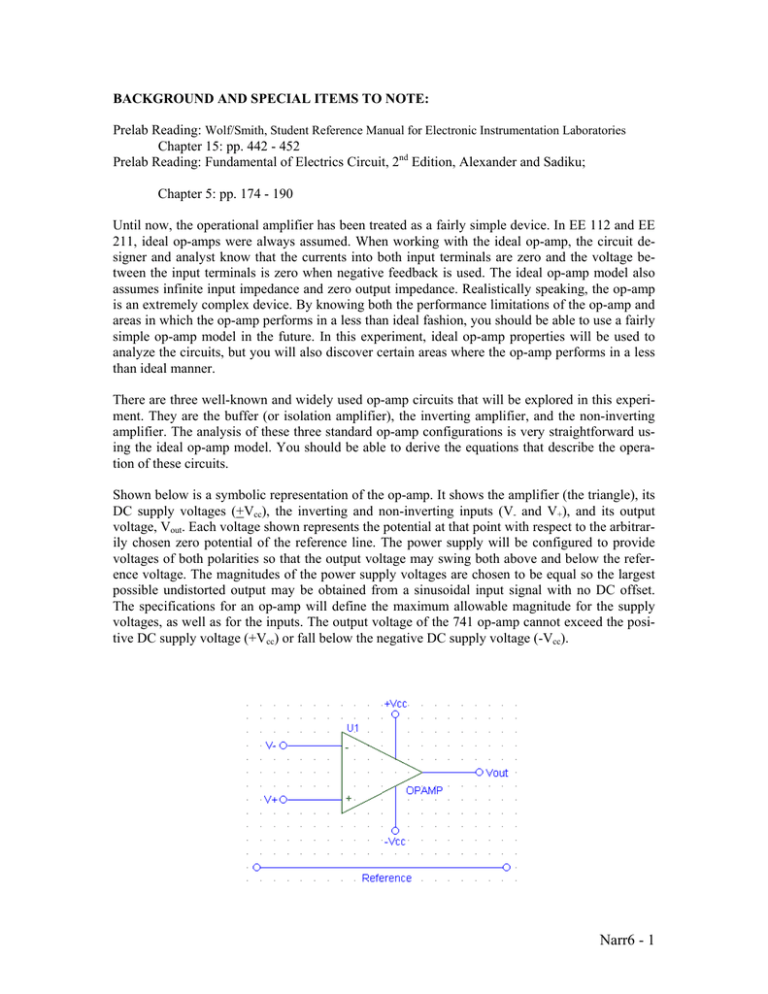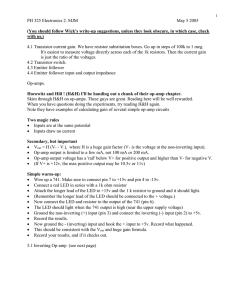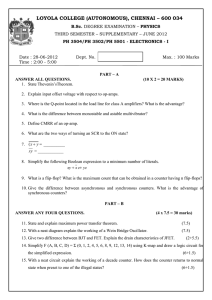Narrative
advertisement

BACKGROUND AND SPECIAL ITEMS TO NOTE: Prelab Reading: Wolf/Smith, Student Reference Manual for Electronic Instrumentation Laboratories Chapter 15: pp. 442 - 452 Prelab Reading: Fundamental of Electrics Circuit, 2nd Edition, Alexander and Sadiku; Chapter 5: pp. 174 - 190 Until now, the operational amplifier has been treated as a fairly simple device. In EE 112 and EE 211, ideal op-amps were always assumed. When working with the ideal op-amp, the circuit designer and analyst know that the currents into both input terminals are zero and the voltage between the input terminals is zero when negative feedback is used. The ideal op-amp model also assumes infinite input impedance and zero output impedance. Realistically speaking, the op-amp is an extremely complex device. By knowing both the performance limitations of the op-amp and areas in which the op-amp performs in a less than ideal fashion, you should be able to use a fairly simple op-amp model in the future. In this experiment, ideal op-amp properties will be used to analyze the circuits, but you will also discover certain areas where the op-amp performs in a less than ideal manner. There are three well-known and widely used op-amp circuits that will be explored in this experiment. They are the buffer (or isolation amplifier), the inverting amplifier, and the non-inverting amplifier. The analysis of these three standard op-amp configurations is very straightforward using the ideal op-amp model. You should be able to derive the equations that describe the operation of these circuits. Shown below is a symbolic representation of the op-amp. It shows the amplifier (the triangle), its DC supply voltages (+Vcc), the inverting and non-inverting inputs (V- and V+), and its output voltage, Vout. Each voltage shown represents the potential at that point with respect to the arbitrarily chosen zero potential of the reference line. The power supply will be configured to provide voltages of both polarities so that the output voltage may swing both above and below the reference voltage. The magnitudes of the power supply voltages are chosen to be equal so the largest possible undistorted output may be obtained from a sinusoidal input signal with no DC offset. The specifications for an op-amp will define the maximum allowable magnitude for the supply voltages, as well as for the inputs. The output voltage of the 741 op-amp cannot exceed the positive DC supply voltage (+Vcc) or fall below the negative DC supply voltage (-Vcc). Narr6 - 1 Shown on the right is an op-amp connected as a two-input amplifier. This configuration should be familiar since it is a more general case of an inverting op-amp configuration. It can be shown that Vout for this circuit can be written as R2 R2 Vout = V2 1 + − V1 R1 R1 R2 R1 V1 - V2 + VOUT For the inverting op-amp configuration, the V2 input is tied to the reference voltage (zero volts) causing the first term to drop out of the equation. This leaves only the second term –(R2/R2)V1. Stated another way, the gain of an op-amp circuit configured as an inverting amplifier is the negative of the ratio of R2 to R1. This ratio can be considered to be a scaling factor of the input voltage. When R2/R1 is greater than 1, the circuit amplifies the input signal. When it is less than 1, the circuit attenuates the input voltage. In both cases, the minus sign is retained, which means that the output voltage is shifted 180o with respect to the input. This can be seen on the scope display. A variation of the inverting op-amp configuration is the summing amplifier. The circuit shown on the right is capable of adding several voltages. Assuming an ideal op-amp and using standard circuit analysis techniques, the output voltage can be found to be R2 Va Rc Rb Vb Vc Ra - VOUT + V1 Once again, if the non-inverting terminal is connected to the reference voltage (zero volts), the first term of the equation will drop out. As you can see, the input voltages associated with the inverting terminal will be added and multiplied by the value of R2. The “gain” of this circuit will be a negative value, so in essence, several positive values are added together and the sum is negated. By changing the values of Ra, Rb, and Rc, the “weights” of the input voltages being summed can be changed. Narr6 - 2 The last op-amp configuration to be examined in this experiment is the non-inverting amplifier shown below. This circuit is obtained by setting V1 = 0 in first circuit of previous page. Vin - The output voltage for the above circuit can be written as VOUT + R2 Vout = Vin 1 + R1 R2 R1 Notice that in this equation, the minus sign is absent, thus, the output will not be shifted by 180o as it was with the inverting amplifier. A non-inverted output can also be obtained by cascading two inverting amplifiers; however, this effect could be obtained more easily by using a non-inverting amplifier. Is it possible to obtain unity gain (gain = 1) using a noninverting amplifier? Another application of the op-amp (a special case of the non-inverting configuration) is that of a voltage follower or buffer. In theory, the output signal should be an exact replica of the input signal. The advantage of this configuration is that the input port has a high-input-impedance and the output port has a low-output-impedance. In one follower configuration, the signal voltage is applied directly to the non-inverting terminal while the op-amp output is connected through an arbitrary resistance to the inverting terminal. Convince yourself using the general equation above that for finite values of R2 and an infinite resistance for R1, the output voltage becomes the voltage at the non-inverting terminal. Vin V OUT + Finally, as a side note, the inputs to an operational amplifier consist of the bases of two separate bipolar transistors. The proper operation of op-amps relies partially on how well these transistors are matched, or stated differently, if they are the same physical size. Since there is always variance in the fabrication process of any integrated circuit, the 741 op-amp provides the circuit designer with a method to adjust for these slight differences. The method is called the offset null and you will use it initially in this experiment to help fine-tune the op-amp to obtain accurate results. Narr6 - 3








